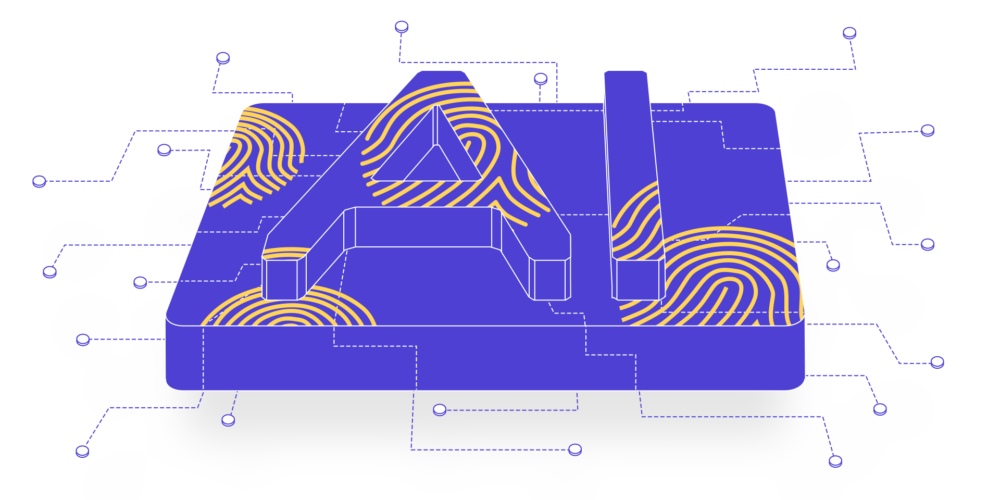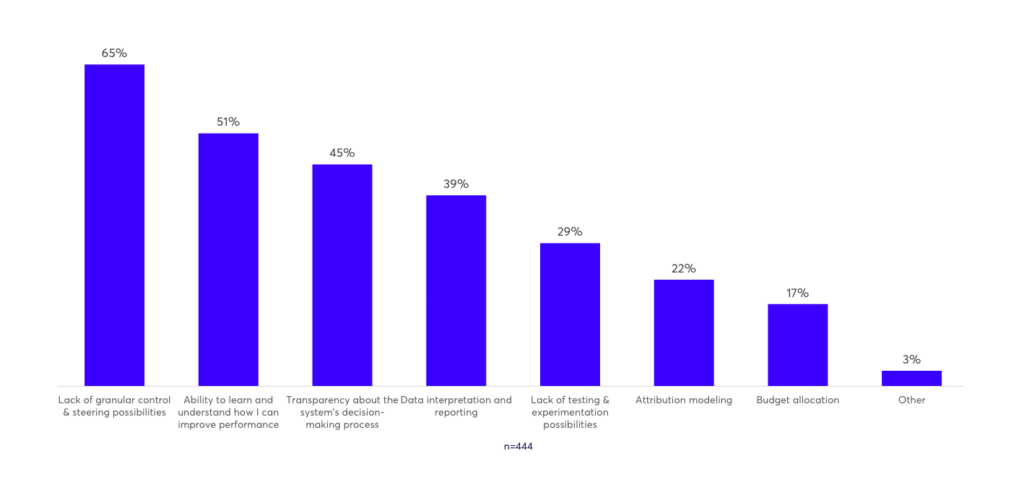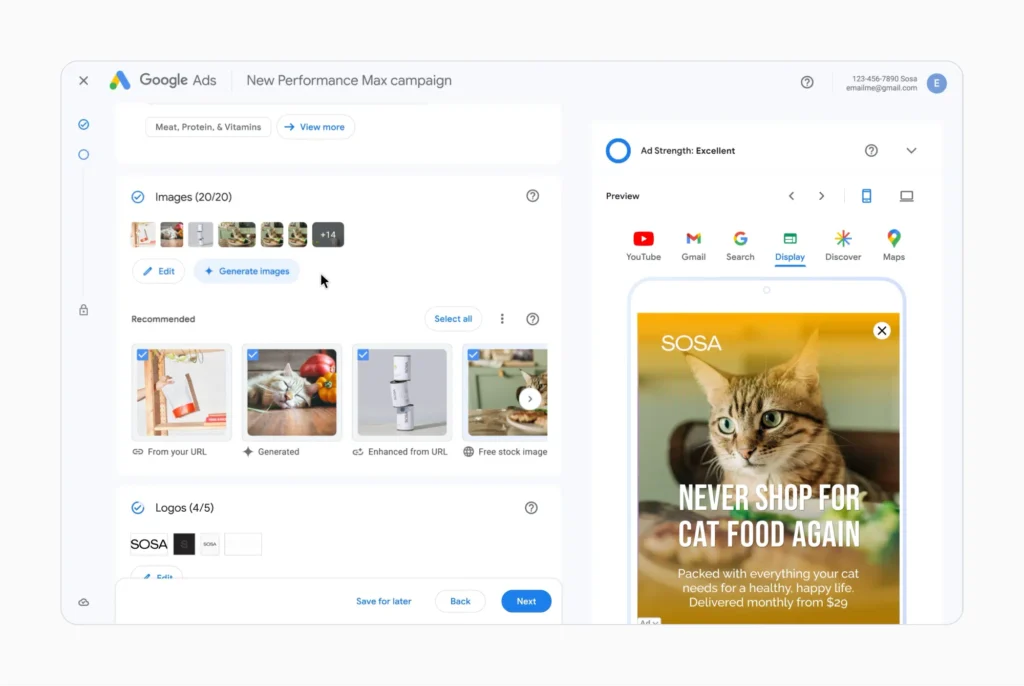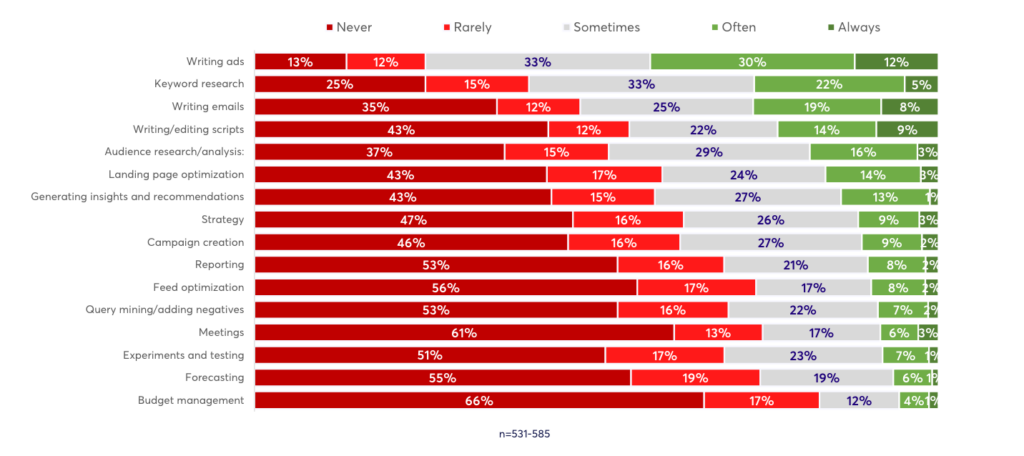Subscribe to join thousands of other ecommerce experts

Let’s talk about the elephant in the room: With the rise of PMax’s AI-driven advertising, what are the chances of technology replacing the human marketer?
The world of PPC marketing has undergone a dramatic metamorphosis in recent years. Google’s introduction of Performance Max (PMax) campaigns marked a turning point. Offering unprecedented levels of automation and efficiency in driving campaigns.
But here’s the catch:
While AI automates campaign optimization and placements, the recent State of PPC report by PPCsurvey.com reveals that a staggering 65% of marketers still grapple with the lack of granular control and transparency with AI-powered digital advertising tools.
This underscores a crucial realization: the future of PPC isn’t a zero-sum game between AI and human expertise. Instead, it’s a powerful collaboration that leverages the strengths of both.
Table of Contents
The AI revolution in Performance Max:
Newfangled ‘Black Box’ campaign types, like Google and Microsoft’s Performance Max, utilize AI to optimize ad placement and performance across all their channels.
We’ve covered the topic of automation in PMax in our Hot PMax questions blog post. I highly recommend you checking it out to get the nitty-gritty of what PMax means for your Google Ads campaigns.
But to give you a quick runthrough: PMax is a powerful tool that streamlines complex campaigns and reaches broad audiences with relatively minimal effort.
So, what’s the problem?
While all this sounds great, many PPC marketers naturally have concerns about AI’s impact on their roles. Particularly AI’s capability to adapt and diversify ads in response to rapidly changing market trends – something human advertisers simply can’t keep up with.
With AI effectively streamlining a good chunk of their current workload, should PPCs fear getting replaced by automation? Indeed, there is a certain basis in reality for these concerns.

The limitations of human input
Let’s be real: The sheer volume of data and the speed at which digital advertising landscapes evolve can be overwhelming for manual management. Additionally, human-curated campaigns can be influenced by inherent biases or preferences, potentially skewing decision-making:
- Data overload: Staying competitive means crunching vast amounts of granular data to create the most impactful campaigns. Manually processing and analyzing these data points to identify trends and opportunities is overwhelming. Our brains are just not built that way.
- Missed opportunities: Human biases or a limited view of the market can lead to overlooking valuable audience segments or emerging trends. This can result in missed business growth opportunities.
- Difficulty with scaling campaigns efficiently: Managing and optimizing complex multi-channel campaigns for vast product ranges is not only time-consuming but also introduces potential for human error and inefficiency.
Here’s an example:
Think of an online fashion retailer launching a new line of clothing. A human-led campaign might broadly target “fashion-conscious consumers,” but this is a wide and diverse group.
Without the help of AI sifting through a multitude of granular data, marketing teams might overlook key subgroups such as eco-conscious shoppers interested in sustainable fashion. Or trendsetters looking for cutting-edge designs, as well as budget shoppers seeking the best bang for their buck.
To help marketers identify these distinct groups, AI can analyze:
- Shopping patterns: AI analyzes customers’ purchase history and frequency, revealing preferences and buying habits.
- Search tends: It tracks keyword searches and search engine queries to understand what draws customers to your products.
- Customer profiles: By assessing demographics, past purchases, and browsing behavior, AI builds a comprehensive view of each customer segment.
This allows retailers to create personalized campaigns that resonate with each specific audience. It also enhances engagement and potentially increases sales.
Sure, technically marketers could do this without the help of AI. But just the amount of time advertisers would need to invest to achieve even a fraction of the actionable output automation crunches within mere minutes is simply not feasible.
So what’s the key takeaway here? Is it time for PPC marketers to give in to the “robocalypse”?
Hold your horses!

AI’s Achilles heel
True. The beauty of AI-driven advertising in PMax lies in the algorithms’ abilities to analyze vast amounts of data to identify patterns and optimize campaigns in real-time.
However: While AI offers incredible efficiency in data processing and pattern recognition, it does introduce several challenges that might stunt the efficiency of your campaigns. Especially within Performance Max:
- Limited control levers: Compared to classic Google Ads campaigns, PMax operates as a “Black Box.” Marketers have less granular control over targeting parameters, bidding strategies, and specific ad placements than they ever had before. While PMax automates these decisions, it’s difficult to understand the reasoning behind the algorithms’ decisions and make adjustments as needed.
- Generic creativity machine: Sure, PMax is highly efficient – but there can be too much of a good thing. Its generative AI feature homogenizes creative assets in the most generic way possible. To add insult to injury, since PMax’s algorithm prioritizes conversions across a broad audience, relying on its creative automation results in ads that lack the specific messaging and brand voice that resonate with unique customer segments.

- Long-term vision vacuum: PMax’s algorithm excels at analyzing past data and optimizing campaigns for short-term goals. However, it can’t develop a long-term strategic vision, understand your brand’s identity, nor create engaging storytelling elements that connect with customers on a more impactful level.
Or to put it in another way …
Performance Max is strategically blind
Performance Max’s strict focus on short-term gains can hinders long-term growth for retailers. Its algorithm particularly struggles with newly introduced products or strategically important items whose strong potential to convert are not yet evident in historical performance data.
Remember the eco-friendly fashion retailer from above?
Say they are introducing a sustainable running shoe line to their catalog that perfectly aligns with a booming consumer trend? Without any granular item-level adjustments, PMax will leave it gathering dust as newly introduced items naturally lack the historical performance data PMax needs to work efficiently. Talk about a missed opportunity!
PMax’s inherent inability to identify products with strong potential beyond performance and strategic brand importance makes it difficult for retailers to develop business strategies that ensure sustainable profitability.
Consequently, retailers relying heavily on PMax’s automation in their PPC strategies miss opportunities to innovate and stay ahead of the competition, which can negatively impact their market position.
How can you counterbalance these AI limitations in PPC?
By granularly understanding how AI in PMax works!
Here’s the thing: Performance Max is inherently data-driven. Its effectiveness increases significantly with the volume and quality of data it receives. Out-of-the-box, however, Performance Max often encounters a significant hurdle: data scarcity.
This data scarcity stems from PMax’s reliance on historical data to structure campaigns. As a result, advertisers are initially provided with only a few options to fine-tune and optimize their campaigns:
- Historical sales data: This is Performance Max’s bread and butter. It analyzes past performance to optimize campaigns for products with a proven track record.
- Campaign structure: PMax organizes campaigns using asset groups that align with specific themes or product categories. Without you guiding the algorithm even a little bit here, it will instantly fall back to historical performance data, which sidelines new or underrepresented products with strong potential.
- Audience targeting: AI can identify user demographics and interests that align with your products. This helps target the right people with the right message.
By understanding how Performance Max’s algorithm operates, you can identify the AI’s potential blind spots. For example, if you’re launching a new product category, you know AI will struggle due to a lack of historical performance data.
This empowers you to be proactive, to provide the algorithm with additional data points or to help PMax understand the potential of these new items.

In essence, becoming an AI marketing whiz isn’t about memorizing algorithms – it’s about understanding AI’s strengths and limitations. Or in other words, in this era of automation, you need to …
Become a PMax expert
Let’s face it, clinging to basic Google Ads tactics is like trying to fight a lightsaber duel with a butter knife. The PPC landscape has shifted, and AI is here to stay.
Are you prepared to become obsolete, or will you rise to the challenge and become a PMax expert?
The good news: This “robocalypse” presents a golden opportunity. With the strong shift in automating and thus homogenizing marketing efforts within these black box platforms, human marketers are at an inevitable crossroad where they need to become more strategic to steer the algorithms towards their goals.
By embracing AI, you can transform from a basic PPC specialist into an invaluable asset – an AI marketing whiz who understands both the power of data and the human touch.
Here’s why simply stringing along with basic tactics won’t cut it anymore:
- AI is a data analysis powerhouse: Imagine sifting through mountains of customer data to identify trends. That’s AI’s playground. However, it can’t understand the “why” behind consumer behavior.
- AI lacks the emotional spark: Crafting narratives that resonate with customers and weaving in brand values – that’s where humans excel. AI can’t replicate the emotional intelligence needed to truly connect.
This is where the magic happens.
It’s all about hitting the sweet spot where AI and human expertise collide:
- AI identifies trends: It analyzes vast data sets, pinpointing emerging consumer interests – in the case of our fashion retailer, this would be a surge in demand for sustainable clothing items.
- YOU become the storyteller: Armed with AI insights, you craft a compelling narrative around this trend. This might involve our fashion retailer’s commitment to ethical practices and sustainable materials
- YOU strategically showcase products: You select and showcase the most relevant items within your business goals, whether it’s highlighting first-party brands or promoting specific product bundles.
- YOU emphasize brand values: This is where you highlight the core principles that define your brand, which resonate deeply with your customers. Whether it’s your commitment to sustainability, innovation, or customer success.
The takeaway: embrace the AI revolution in PMax
The most effective digital marketing strategy isn’t a battle between AI and human expertise, it’s a powerful partnership. AI provides the data-driven foundation, but you, the AI marketing expert, build upon it with strategic thinking, creative narratives, and emotionally-charged campaigns.

A multi-dimensional approach:
At smec, our approach to highly-automated PMax campaigns is multi-dimensional. We help PPC marketers to leverage AI’s efficiency for the handling of data-heavy tasks, all while they can focus on their strategy and creativity.
PMax throws a lot of data your way, but it can’t tell you the whole story. Metrics like ROAS are important, but they don’t reveal hidden opportunities within specific product categories or price ranges. Manually analyzing this data for actionable insights is a massive time suck.
smec’s AI-powered solution allows you to feed the black box algorithm with a multitude of superior item-level data across multiple dimensions, including:
- Average Order Value (AOV): Pinpoint products where up- and cross-selling tactics can be most effectively applied to maximize revenue.
- Profit focus: Adjust your advertising spend on the most lucrative items in your catalog to ensure they receive the proper focus in your campaigns.
- Key product lines: Identify and prioritize your advertising focus on product lines most important to achieving your business goals. Whether they are first-party products or items from profitable partnerships with other brands.
- Seasonality: Leverage historical data to anticipate seasonal trends and optimize campaigns accordingly. This ensures you’re reaching the right audience with the right message at the perfect time.
| Pain points | Human marketers | AI | smec |
| Granular control | No | No | Yes |
| Adaptability to rapid market changes | Yes | No | Yes |
| Easy data crunching | No | Yes | Yes |
| Strategic brand push | Yes | No | Yes |
| Long-term strategic planning | Yes | No | Yes |
| Campaign scalability | No | Yes | Yes |
Armed with these insights, PPC marketers can:
- Gain granular control: Precise targeting and campaign adjustments based on market trends and consumer insights enable marketers to fine-tune their campaigns to …
- … achieve better business results: By aligning AI with their overall goals, marketers can create campaigns that directly affect their bottom line – moving beyond basic metrics like ROAS.
- Enhance scalability: The time saved from error-prone, manual campaign adjustments can be directed towards crafting long-term business strategies.
- Deepen their know-how: By collaborating with our PPC experts , PPC marketers benefit from insights that are not only valuable, but instantly actionable.

Making sense of the AI limitations in PPC:
Long story short: AI is a powerful tool that, when fed with the right data, excels at optimizing tasks and predicting outcomes with astonishing accuracy. But that’s the thing: AI needs this data in the first place.
Black boxes like PMax need the guiding hand of human marketers with their diverse strategic thinking to guide them towards the most impactful business outcomes. Without this crucial input, even the most advanced AI will miss the mark.
Let’s bridge the gap!
smec is your facilitator, bridging the gap between PMax automation and human control.
Don’t just manage your PMax campaigns, master them. Partner with smec and harness AI efficiency and strategic human insights to craft campaigns that don’t just meet but exceed your business goals.
Whether it’s boosting ROI, expanding into new markets, or driving higher conversions. We’ve got you covered.
Contact smec today and discover how our solution can help you achieve PMax mastery.

